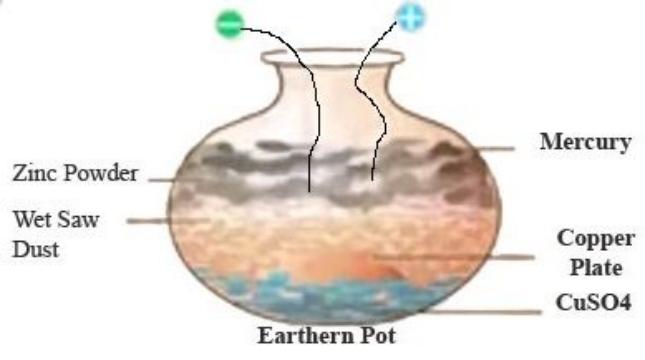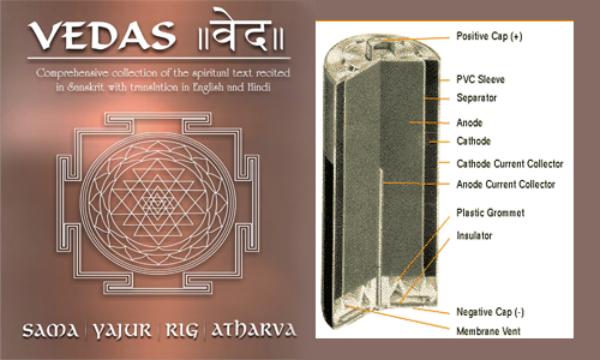Hi guys,,,,,,,
Before starting this blog share this as much as possible its my request please. Today we are going to know about the man who discover electricity. Some of them may say about great scientist like Benjamin franklin, Thomas alva Edison, Nikola tesla, William gilbert, Micheal faraday, Ottó Bláthy, or Albert einsten discover the electricity. But its wrong, around 1000 years back Indian sage "Agastya maharshi" wrote about the battery technology in Sanskrit language.
On September 30, 1927 Indian based american bussiness man Dr. Kookatnoor who explore the book "Agastya Samhita" because of his hard and smart research. And Andrew thomas also explore this idea in the his book called "We are not first".
The ancient text of Agastya Samhita describes the method of making electric battery, and that water can be split into oxygen and hydrogen.
Modern battery cell resembles Agastya’s method of generating electricity.
For generating electricity, Sage Agastya had used the following material:
1.One earthen pot
2.Copper plate
3.Copper sulphate
4.Wet saw dust
5.Zinc amalgam
His text says : “Sansthapya Mrinmaya Patre
Tamrapatram Susanskritam
Chhadyechhikhigriven Chardrarbhih
Kashthpamsubhih.
Dastaloshto Nidhatavyah
Pardachhaditastah
Sanyogajjayte Tejo
Mitravarunsangyitam”
संस्थाप्य मृण्मये पात्रे ताम्रपत्रं सुसंस्कृतम्।
छादयेच्छिखिग्रीवेन चार्दाभि: काष्ठापांसुभि:॥
दस्तालोष्टो निधात्वय: पारदाच्छादितस्तत:।
संयोगाज्जायते तेजो मित्रावरुणसंज्ञितम्॥
Which means, “Place a well-cleaned copper plate in an earthenware vessel. Cover it first by copper sulfate and then by moist sawdust. After that, put a mercury-amalgamated zinc sheet on top of the sawdust to avoid polarization. The contact will produce an energy known by the twin name of Mitra-Varuna. Water will be split by this current into Pranavayu and Udanavayu. A chain of one hundred jars is said to give a very effective force.”
When a cell was prepared according to Agastya Samhita and measured, it gives open circuit voltage as 1.138 volts, and short circuit current as 23 mA.
Anen Jalbhangosti Prano Daneshu
Vayushu
Evam Shatanam
Kumbhanamsanyogkaryakritsmritah.
if we use the power of 100 earthen pots on water, then water will change its form into life-giving oxygen and floating hydrogen.
Vayubandhakvastren Nibaddho
Yanmastake
Udanah Swalaghutve
Bibhartyakashayanakam.
If hydrogen is contained in an air tight cloth, it can be used in aerodynamics, i.e. it will fly in air. (Today’s Hydrogen Balloon)
Process Of Electroplating by Maharshi Agastya in Agastya Sanhita:
Excerpt from “Technology of the Gods: The Incredible Sciences of the Ancients” – By David Hatcher Childress
“In the temple of Trivandrum, Travancore, the Reverned S. Mateer of the London Protestant Mission saw ‘a great lamp which was lit over one hundred and twenty years ago’, in a deep well in side the temple. ……. On the background of the Agastya Samhita text’s giving precise directions for constructing electrical batteries, this speculation is not extravagant.”
Agastya Samhita, written thousands of years ago contains methods to construct an electric battery or cell, and also, how to utilize the battery to ‘split‘ water into its constituent gasses (Hydrogen an Oxygen).
Modern battery cell resembles Agastya’s method of generating electricity. For generating electricity, Sage Agastya had used the following materials : One earthen pot, Copper plate, Copper sulphate, Wet saw dust, Zinc amalgam.A clean copper plate is put in an earthenware vessel.
It is covered first by copper sulfate and then moist sawdust.
After that put a mercury-amalgamated-zinc sheet on top of an energy known by the twin name of Mitra-Varuna.
Water will be split by this current into Pranavayu (Oxygen) and Udanavayu (Hydrogen).
A chain of one hundred jars is used to give a very strong electricity.
Mitra is cathode , Varuna is anode , Pranavayu is oxygen, Udanavayu is hydrogen, Ghritachi is earthen ceramic beaker, Shata Kumbh is 100 cells in series to convert chemical energy to electrical energy, Apsara is water tight vessel..
अगस्त्य संहिता शिल्प सूत्र – From Agastya Samhita, Shilpa Sutra (theory of architecture) – This verse gives following information :
संस्थाप्य मृण्मये पात्रे ताम्रपत्रम् सुसंस्कृतम् ।
छादयेत शिखिग्नीवेनार्दाभिः काष्ठपांसुभिः ॥
दस्तालोष्ठो निघातव्यः पारदाच्छादितस्ततः ।
संयोगात जायते तेजो मित्रावरुण संज्ञितम् ॥
अनेन जलभंगोस्ति प्राणोदानेषु वायुषु।
एवम् शतानाम् कुंभानाम् संयोगः कार्यकृत्स्मृतः ॥
वायु बंधक वस्त्रेण निबद्धो यंमस्तके।
उदान: स्वलघुत्वे बिभर्त्याकाश यानकम ॥
Electrical energy is produced by this particular assembly of chemicals and wire, that energy is of dual nature.
Water can be split using that energy. Upon splitting of water, 2 gasses are produced.
The energy can be amplified if the cells are assembled in series.
There exists a material OR a fabric which is airtight and which can be harnessed to build a structure which won’t allow air to escape.
Udaan vaayu, which is produced after splitting water, can be trapped in such air-tight assembly.
Udaan vaayu is light and self-buoyant (hydrogen in light weight)
The self-buoyancy of Udaan vaayu can be harnessed to build a structure which is capable of flying in air.
Sage Agastya discovered that Hydrogen is light weight (even lighter than Helium) and can be used to fly objects in air.
Helium replaced Hydrogen in balloons because it does not catch fire.
Mitra-Varuna are twin deities like Ashwini kumar. They always exist in pair, like Dyava-Prithvi.
The energy which is generated from above mentioned assembly exists in pair and cannot exist individually.
This refers to positive and negative terminals of cell and charges of electric field.
One cannot exist without another, they have to exist in pair, just like Mitra-varuna.
It is an example of analytical and deductive nature of human brain.
Rishis in ancient India produced 6 types of electricity using technology in Vedas :
1. Tadit — the one produced by friction from leather or silk,
2. Saudamini — that produced by friction from gems or glass,
3. Vidyut — produced from clouds or steam,
4. Satakoti (or) Satakumbhi — that produced from a battery of hundreds of cells,
5. Hradini — that obtained from storage cells,
6. Asani — the one emanating from a magnetic rod.
Golden veneer jewellery electroplated from Silver, was in common use in the ancient days. Indian Vimanas had accumulator batteries.
Later, Electrical Bulbs were in used in Ancient Egypt too. They had filaments and were manually ignited.

The famous Baghdad Battery also is similar to the dry cell made using Agastya Samhita.

For information you guys can refer this video which is in kannada language. The video link is given below.
"https://youtu.be/e9Q0yaoRQbk".
"Bharat ke mitti mein jaddu hai, but we Indian never explore this invension and new things which the world want, so we are lacking behind the world with the foreign invension or discovery".
So my request is that share this blog to know the value of Indian so please share this blog.
Thank you for reading my blog...............☺️☺️☺️☺️☺️

This comment has been removed by the author.
ReplyDeleteThanks for providing this information I was searching the name of book in which Andrew Thomas has mentioned about invention of electricity by Agstya rishi, from many times but now my search is complete.😊
ReplyDeleteDo you know that some of electrical appliances consume electricity a lot more than you imagine. In this article I will tell you what these big consumers are and give you some tips on save money on your electricity bill. https://iescobill.pk/
ReplyDeleteDon't miss CNET's hands-on reviews, buying guides and videos on a wide range of products. We make it easier to find the right tech devices, smart home gear, kitchen tools, cars and much more.
ReplyDeleteI dont know if someone has already told you this, and even if they have I want to confirm what they probably have said before – you are simply beautiful.
ReplyDelete